
Zaltbommel municipality / Gemeente Zaltbommel (G)
Zaltbommel is een historische stad en een gemeente in de Bommelerwaard in het zuid-westelijke deel van Gelderland. De gemeente omvat het grootste gedeelte van de Bommelerwaard, een eiland tussen de rivieren Waal en Maas. Deze pagina toont kerken in Zaltbommel en in enkele dorpen in de gemeente en is niet compleet.
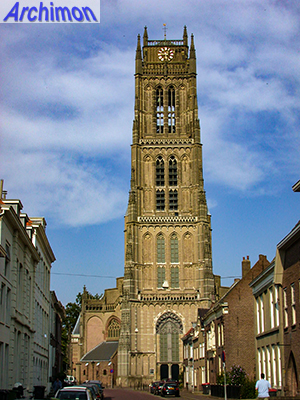
The Grote- of St. Maartenskerk ("Great Church or Church of St. Martin") is one of the best preserved examples of Lower Rhine Gothicism. While the choir dates from the 14th century and is rather modest in style, the nave and especially the tower are richly ornamented. During the Reformation it became a protestant church but it is no longer used for regular services.
Location: Kerkplein 1
Locatie: Kerkplein 1

The Gasthuiskapel was built as the chapel of a hospital in the 15th century. The aisleless building must originally have been in Gothic style, but it was drastically altered in the 19th and 20th centuries.
Location: Gasthuisstraat 34
De Gasthuiskapel werd in de 15e eeuw gebouwd als de kapel van een gasthuis of hospitaal. De zaalkerk moet oorspronkelijk in gotische stijl zijn geweest, maar het gebouw is drastisch veranderd in de 19e en 20e eeuw.
Locatie: Gasthuisstraat 34
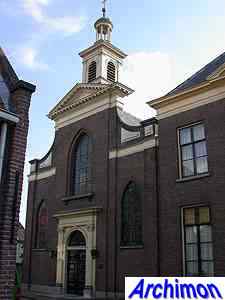
The Roman Catholic St. Martinus dates from 1837 and is in neo-Classical style. It's very similar to many other churches from the same period, and was designed by government engineer E. Kroon. The original choir was replaced in 1939 by a new one designed by J. Franssen.
Location: Oliestraat 28
De rooms-katholieke St. Martinus dateert uit 1837 en is in neoclassicistische stijl. Zij is zeer vergelijkbaar met veel andere kerken uit dezelfde periode, en is ontworpen door waterstaatsingenieur E. Kroon. Het koor werd in 1939 vervangen door een nieuwe ontworpen door J. Franssen.
Locatie: Oliestraat 28
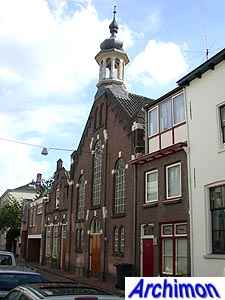
Eben Haëzer is the name of this protestant church, designed by E.G. Wentink and built in 1900. Originally it was built for the calvinist Gereformeerden denomination but as a result of increased cooperation between protestant denominations it is now used by all protestants.
Location: Korte Steigerstraat 11
Eben Haëzer is de naam van deze protestantse kerk, ontworpen door E.G. Wentink en gebouwd in 1900. Oorspronkelijk werd het gebouwd voor de Gereformeerden, maar als gevolg van de toegenomen samenwerking tussen de protestantse denominaties wordt het nu gebruikt door alle protestanten.
Locatie: Korte Steigerstraat 11
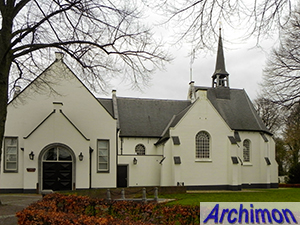 The
reformed church
is an aisleless church in Gothic style with an early-14th century nave and a
higher choir built later that century. At the south side a chapel was added
in the 15th century. Unfortunately the church was enlarged in 2005 by adding
a new building at the front.
The
reformed church
is an aisleless church in Gothic style with an early-14th century nave and a
higher choir built later that century. At the south side a chapel was added
in the 15th century. Unfortunately the church was enlarged in 2005 by adding
a new building at the front. Location: Kerkplein 1
De hervormde kerk is een éénbeukige kerk in gotische stijl met een schip uit het begin van de 14e eeuw en een hoger koor dat later die eeuw werd gebouwd. Aan de zuidkant werd in de 15e eeuw een kapel toegevoegd. Helaas is de kerk in 2005 vergroot door een nieuw gebouw aan de voorzijde toe te voegen.
Locatie: Kerkplein 1

The Reformed church is a largely Romanesque church with an aisleless nave from the 12th century and a tower from the13th century. The Gothic choir is from the 15th century.
Location: Aalderwijksestraat 16
De Hervormde kerk is een grotendeels romaanse kerk met een eenbeukig schip uit de 12e eeuw en een toren uit de 13e eeuw. Het gotische schip stat uit de 15e eeuw.
Locatie: Aalderwijksestraat 16

The reformed church, now belonging to the restored reforme church, is an aisleless church with a stretched octagonal ground plan, built in 1776 in a simple Classical style.
Location: Kerkplein 1
De hervormde kerk, nu behorend tot de hersteld hervormde kerk, is een zaakkerk met een langgerekte achthoekige plattegrond, gebouwd in 1776 in een eenvoudige classicistische stijl.
Locatie: Kerkplein 1
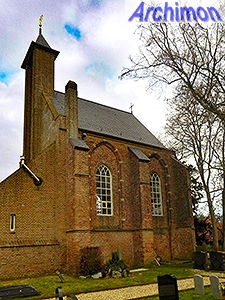
The Eilandkerk ('island church', referring to its location at a peninsula) is the remaining 16th-century Gothic choir of a bigger church, the rest of which was destroyed in 1944. The current front part was built as part of a restoration in 1955-1958.
Location: Kerklaan 5
De Eilandkerk (de naam verwijst naar de ligging op een schiereiland) is het overgebleven 16e-eeuwse gotische koor van een grotere kerk, waarvan de rest in 1944 werd verwoest. Het huidige voorste deel werd gebouwd als onderdeel van een restauratie in 1955-1958.
Locatie: Kerklaan 5

The Gerformeerde kerk is a small aisleless church built in ca. 1860 in a simple non-descript style.
Location: Ouwelsestraat 8
De Gereformeerde kerk is een kleine zaalkerk gebouwd in ca. 1860 in een eenvoudige, niet-specifieke stijl.
Locatie: Ouwelsestraat 8
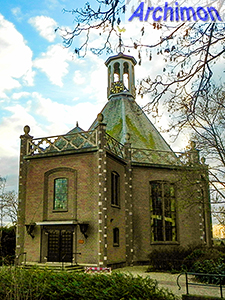
The reformed church is an octagional church in Traditionalist style, designed by J.G. Mensink and built in 1954 as a replacement for a previous church which was destroyed in 1945.
Location: Delkant 1
De hervormde kerk is een achthoekige kerk in traditionalistische stijl, ontworpen door J.G. Mensink en gebouwd in 1954 ter vervanging van een vorige kerk die in 1945 werd verwoest.
Locatie: Delkant 1